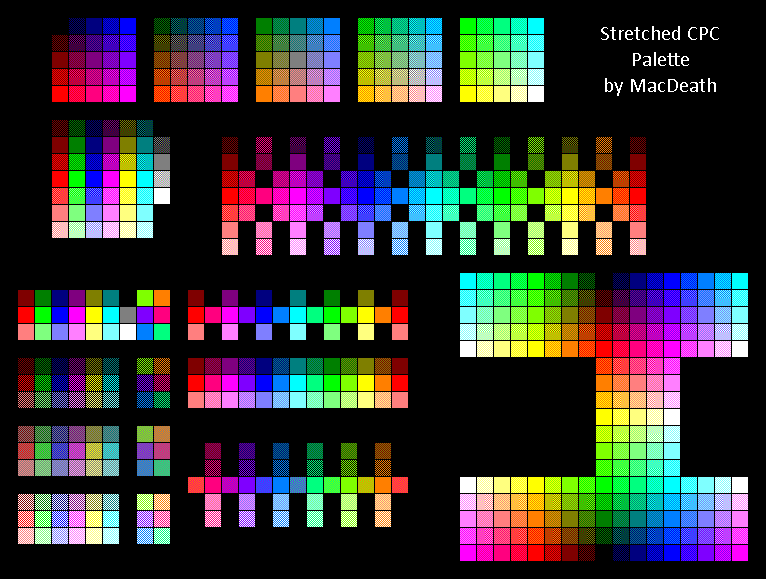| Firmware Number | Hardware Number | Colour Name | R % | G % | B % | Hexadecimal | RGB values | Colour |
| 0 | 54h | Black | 0 | 0 | 0 | #000000 | 0/0/0 | |
| 1 | 44h (or 50h) | Blue | 0 | 0 | 50 | #000080 | 0/0/128 | |
| 2 | 55h | Bright Blue | 0 | 0 | 100 | #0000FF | 0/0/255 | |
| 3 | 5Ch | Red | 50 | 0 | 0 | #800000 | 128/0/0 | |
| 4 | 58h | Magenta | 50 | 0 | 50 | #800080 | 128/0/128 | |
| 5 | 5Dh | Mauve | 50 | 0 | 100 | #8000FF | 128/0/255 | |
| 6 | 4Ch | Bright Red | 100 | 0 | 0 | #FF0000 | 255/0/0 | |
| 7 | 45h (or 48h) | Purple | 100 | 0 | 50 | #FF0080 | 255/0/128 | |
| 8 | 4Dh | Bright Magenta | 100 | 0 | 100 | #FF00FF | 255/0/255 | |
| 9 | 56h | Green | 0 | 50 | 0 | #008000 | 0/128/0 | |
| 10 | 46h | Cyan | 0 | 50 | 50 | #008080 | 0/128/128 | |
| 11 | 57h | Sky Blue | 0 | 50 | 100 | #0080FF | 0/128/255 | |
| 12 | 5Eh | Yellow | 50 | 50 | 0 | #808000 | 128/128/0 | |
| 13 | 40h (or 41h) | White | 50 | 50 | 50 | #808080 | 128/128/128 | |
| 14 | 5Fh | Pastel Blue | 50 | 50 | 100 | #8080FF | 128/128/255 | |
| 15 | 4Eh | Orange | 100 | 50 | 0 | #FF8000 | 255/128/0 | |
| 16 | 47h | Pink | 100 | 50 | 50 | #FF8080 | 255/128/128 | |
| 17 | 4Fh | Pastel Magenta | 100 | 50 | 100 | #FF80FF | 255/128/255 | |
| 18 | 52h | Bright Green | 0 | 100 | 0 | #00FF00 | 0/255/0 | |
| 19 | 42h (or 51h) | Sea Green | 0 | 100 | 50 | #00FF80 | 0/255/128 | |
| 20 | 53h | Bright Cyan | 0 | 100 | 100 | #00FFFF | 0/255/255 | |
| 21 | 5Ah | Lime | 50 | 100 | 0 | #80FF00 | 128/255/0 | |
| 22 | 59h | Pastel Green | 50 | 100 | 50 | #80FF80 | 128/255/128 | |
| 23 | 5Bh | Pastel Cyan | 50 | 100 | 100 | #80FFFF | 128/255/255 | |
| 24 | 4Ah | Bright Yellow | 100 | 100 | 0 | #FFFF00 | 255/255/0 | |
| 25 | 43h (or 49h) | Pastel Yellow | 100 | 100 | 50 | #FFFF80 | 255/255/128 | |
| 26 | 4Bh | Bright White | 100 | 100 | 100 | #FFFFFF | 255/255/255 |
- Note : Actually both RGB's 127 (#7F) or 128 (#80) values can be used to generate the CPC palette's half tones on a true colour modern computer.
CPC6128 R,G,B signals (measured by nocash)
The pictures are showing the RGB outputs on a CPC6128 with classic (non-cost-down) mainboard (measured between the monitor connector and R126,R128,R130). Each divider is 100mV in height.
The CPC is connected to the RGB input of a Philips Philetta TV Set (this is important for the test, as the monitor does pull-down the signals, without monitor connected both "max" and "half" signals are around 4.0V, with monitor connected they drop to circa 1.0V and 0.5V, as seen in the pictures).
Stretching the Palette
- CPC palette is a 3x3x3 RGB cube that can be stretched into 5x5x5 RGB cube via ditherings or fast colour swap (flashouille).
- While some mixes of colours are supposed to produce the same colour (in theory), the properties of pixels and the variation of their percieved size depending on their intensity or the number of luminophores used to produce a colour may give actual slight and subtle differences. May also vary from one machine or screen to another, or between PLUS range and CPC classic range.
Related Pages
Other systems using the same palette
- The Toshiba PASOPIA 7 is known to feature the same 3-values RGB palette as the Amstrad CPC, its video mdoes are different than Amstrad CPC's ones though.
Weblink
- http://grimware.org/doku.php/documentations/devices/gatearray - describes the intensities in great detail




